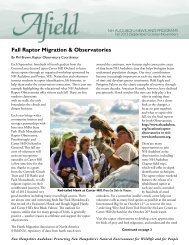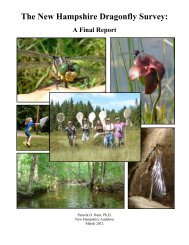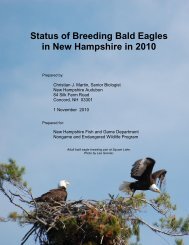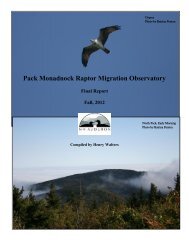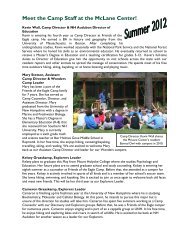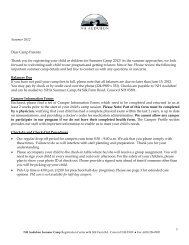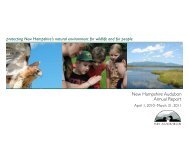Carter Hill Raptor Observatory - New Hampshire Audubon
Carter Hill Raptor Observatory - New Hampshire Audubon
Carter Hill Raptor Observatory - New Hampshire Audubon
Create successful ePaper yourself
Turn your PDF publications into a flip-book with our unique Google optimized e-Paper software.
Results<br />
Over the course of the fall, 7,142 raptors of 16 species were counted migrating past <strong>Carter</strong> <strong>Hill</strong>,<br />
7,046 of them in the official count period of September 1 st to October 31 st . The additional 96 birds<br />
counted in the 46.25 hour logged in November may not seem too significant when looking at overall<br />
numbers, but they accounted for the only rough-legged hawks, among a few other notable species and<br />
numbers. The site‟s first record of a black vulture came through on September 21 st , making history as<br />
the first of its kind to be observed in the entirety of Concord! Two golden eagles were also observed,<br />
the highest season total for this species in the five years of hawk watching at the <strong>Observatory</strong>.<br />
Many raptor species showed a record increase over previous seasons‟ numbers, and MOST<br />
species set new season records in 2012. There are several factors that this may be attributed to, and<br />
analysis of a single season of migration cannot be used on its own to make accurate determinations<br />
about actual population size of species. Still, some observations about this season can be made. The<br />
2012 season had more observers scanning the skies, and far more hours were logged this year (418)<br />
than any past season. Observer hours have grown consistently at the <strong>Observatory</strong> each of the past four<br />
years. As observer experience builds, individuals have become more adept at finding and identifying<br />
birds, a trend that we hope to carry into future seasons.<br />
With the exception of a couple of significant weather events, including Hurricane Sandy in late<br />
October, which shut down migration – and the hawk watch – for several days, there were generally<br />
excellent weather conditions for migrants for much of the count. The first part of October, when most<br />
species reached their peaks, was notable. Also, many raptor populations are holding steady or on the<br />
rise, and we should continue to expect bald eagle, Cooper's hawk, peregrine falcon, and turkey vulture<br />
numbers to grow. For other species like the American kestrel and Northern harrier, which are both in<br />
decline, their heightened numbers could reflect a good flight year where conditions were potentially<br />
favorable on breeding grounds, or, for simply ushering more birds than usual over the <strong>Observatory</strong>. The<br />
overall season total was lower than 2011‟s record season as fewer broad-winged hawks were tallied, but<br />
it was still an above-average count.



